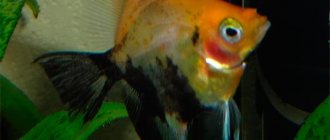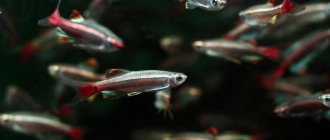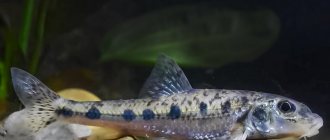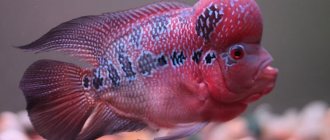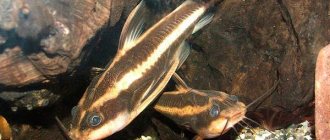Home/FISH/Angelars: compatibility with other fish
Angelfish is one of the most beautiful and unpretentious fish. They often occupy the main place in the aquarium. They are also called angelfish due to their elegance and beautiful fins that look like angel wings. However, before purchasing them for an aquarium, it is important to know with whom the neighborhood is considered comfortable for them, and who absolutely cannot be kept in the same aquarium.
Compatible with each other
When keeping fish from an early age, conflicts do not arise. Monitor new adults. If other fish behave aggressively, then remove the newcomer.
Angelfish from different habitats do not get along. For example, an angelfish from Africa will not coexist with a species from Asia. Fish from other countries do not understand each other's signals. This leads to misunderstandings and quarrels between individuals.
Can an angelfish live alone in an aquarium?
This type of fish is a schooling animal, so keeping one fish is not worth it.
Description
Angelfish are distinguished by their extraordinary, special beauty. Their body is shaped like a crescent moon. The sizes of these fish are quite large - body length reaches 15 cm or more, and height - 25 cm. Its shape is flattened laterally and almost completely flat.
Angelfish are sometimes called angelfish because of their interesting, unusual fins that flutter like wings. This is especially true for the dorsal and caudal fins, which are quite elongated. With their help, they seem to float. The pelvic fins resemble threads; they act as an antenna. Angelfish are slow, but at the same time very elegant and graceful, which also attracts aquarists. Beautiful smooth movements are distinguished by special sophistication and charm.
As for color, in nature angelfish have discreet silver scales with transverse dark stripes. Thanks to this, they can camouflage well and hide among aquatic plants. However, it is interesting that breeders have bred many varieties of angelfish with bright colors - red, blue, black, leopard, etc. And aquarists really like such forms, because in combination with an unusual body structure and grace, this especially attracts attention.
Who are they compatible with?
Pterophyllums are the calmest and most peaceful individuals from the Cichlid family. But they remain predatory fish.
Aquarium fish compatible with angels:
- Catfish.
- Gourami.
- Botsiya.
- Mollies.
- Pecilia.
- Rainbows.
- Rasbory.
- Labeo.
- Tetras.
These species are the best neighbors that can be added to angelfish.
Soma Corydoras
Corydoras catfish are the best choice of neighbors. Because of their measured lifestyle, they get along with almost everyone. In the same aquarium, catfish and angelfish almost never intersect and do not notice each other. They are located at the bottom and take up little space.
If you live together, watch your feeding. Catfish food is eaten by others before falling to the bottom. Buy special food that quickly sinks to the bottom.
Characteristics of the angelfish
The angelfish has other names: floating crescent or angel. All this is associated with an elegant appearance, beautiful fins resembling wings. And also with an unusual body shape and beautiful varied colors. Many people love these fish, considering them calm and peaceful, although they belong to the cichlid family. That is, they are predators capable of demonstrating appropriate instincts. Therefore, not every other fish is suitable for living together. The small inhabitants of the angelfish can easily be eaten. And larger or more active specimens will begin to attack it.
Note the basic rule that ensures compatibility. Peaceful coexistence will be possible if the inhabitants of the aquarium grow up together. It is better if they are close by from birth, which will lead to a pack feeling.
There are other sides to the character of the angelfish.
- Active, this fish never stands still.
- Demanding about living conditions, reaching the point of whims. She needs clean water and quality food. Care and maintenance requires preliminary preparation from the owner. This also applies to the selection of neighbors along the pond who need similar conditions.
- The character description includes such a quality as flocking. This fish does not tolerate a lonely lifestyle and is faithful to its partners. Therefore, it is better to plant them in groups of 4 to 6 specimens.
- Moreover, a hierarchy is established in the company of fish. The big couple takes the best angle, while the others make do with what's left. Lonely individuals are expelled and eat last. And when an isolated fish moves out, its place is immediately taken. The problem of collectivity is solved by the size of the aquarium or the size of the flock.
- Shyness is also noted in the character. Fish react to knocking or turning on a light. Sometimes angelfish have a strong impression, which leads them to severe stress and, as a result, loss of their coloring.
- All cichlids are individualists. Therefore, it is not always easy to resolve the issue of compatibility with other fish.
A flock of angelfish must consist of at least 5 individuals.
A small mouth, slowness and peaceful disposition do not exclude belonging to a predatory family. Especially during spawning, angelfish show territoriality, as a result of which other inhabitants are dispersed into the corners of the reservoir.
If only angelfish were raised in the aquarium, it will be problematic or impossible to add someone to them as an adult. A foreign individual will risk its health due to an attack by a flock.
Relatively compatible species
They cohabit with angelfish only if there are certain conditions in the aquarium.
Relatively compatible species:
- barbs;
- zebrafish;
- swordtails;
- neons;
- thorns;
- acne;
- shrimp and freshwater crabs.
Barbs
Species from the Karpov family. A flock of barb fish in the same aquarium with pterophyllums gets along well and are favorable neighbors. But one fish will be more aggressive - nibble on fins and inflict wounds. Angelfish and barbs are kept together only if there are several barbs in the aquarium.
Diseases
The following diseases may occur in angelfish:
Hexamitosis
indigestion, as a result of which the fish secretes undigested food residues, the anus becomes inflamed, then the angelfish refuses to eat at all and loses weight. This disease is caused by a single-celled flagellate. Treatment – heating water to 350 C and adding trichopolum 100 mg/15 l of water to the water for 3 days;
Glucose
Sporovirus infection, as a result of which the fish's eyes bulge and growths appear on the body. This disease causes loss of balance and has no cure;
Fin rot
First, the fish's fins become discolored, then the entire surface of the body becomes cloudy. Without treatment, the entire body, starting with the tail, rots. Treatment is carried out by raising the water temperature and adding streptocide in the amount of 1.5 g/10 l or chloramphenicol (1/2 t/10 l.
Incompatible fish
For small species of angelfish, angelfish are dangerous; large and hostile species of fish pose a danger to the angelfish themselves.
Incompatible fish species:
- African cichlids;
- South American cichlids;
- discus;
- goldfish;
- cockerels;
- guppy;
- koi carp;
- astronotuses;
- analysis.
African and South American cichlids
Cohabitation with African and South American cichlids is impossible. They have an aggressive character and love to start fights. Calm angelfish become stressed, get injured, and remain hungry.
Discus
Discus fish are not suitable for living together with other fish; they will only get along with individuals of their own species. The predatory nature and aggressiveness of discus fish leads to fights.
Goldfish
Goldfish and angelfish will not be suitable neighbors due to their different habitat conditions. Pterophyllums are heat-loving and demanding of water purity. Goldfish prefer cool water temperatures and like to dig up soil and stir up mud. Angelfish and goldfish do not get along because of their different personalities. Angelfish are active and aggressive to goldfish. They bite, tear off fins, and start conflicts.
Reproduction
The barb, whose compatibility with other fish was discussed above, belongs to the spawn-marking class. At one time, the female can bring up to 500 eggs. Producers will need to be seeded before spawning. Particular attention should be paid to proper feeding at this time. Fish need to be given a lot of live food. After spawning, females are removed from the aquarium. The fry begin to be fed on the third day after hatching. Very young children are fed rotifers or artemia. In the future, larger types of food can be given. The fry should be fed very often, which is due to their very rapid growth.
Thus, the compatibility of barbs with other fish, active and non-aggressive, is beyond doubt. It is better not to house them together with representatives of the underwater world that are slow, timid, or have beautiful long or wide fins. If you want to see these beautiful, interesting, live fish in your aquarium, you should definitely take this into account. And, of course, you need to care for barbs correctly. In this case, there will be much fewer problems with their maintenance.
fb.ru
What you should pay attention to
When introducing other fish, angelfish are hostile and aggressive towards the appearance of new inhabitants in the aquarium.
Wrong choices increase the stress level of all inhabitants. Small fish will be eaten, and larger fish will sometimes attack the angelfish. But among the peace-loving representatives there are also aggressive individuals. When introducing any animals, it is necessary to control their behavior.
Consider day length, feeding schedule, water temperature, aggressiveness, activity and behavior for each fish.
Basics of care
Let's look at how to create optimal conditions for keeping angelfish. It is necessary to take into account the need for the following number of factors.
An aquarium for angelfish must be equipped taking into account their natural habitat. Including the need to make a lot of shelters.
- Selection of an aquarium taking into account the fact that individuals sometimes grow large, which will require a capacity of approximately 80 liters for 4 pieces. And this is for average-sized fish. The width of the reservoir is not very important, but the height is needed at least 45 cm.
- Temperature conditions: approximately 23 or 26 °C.
- The acidity level of the medium is from 6.5 to 7.4 with a hardness of 18.
- The pure state of water, which requires a filter that creates a gentle current. Every day you need to change 1/5 of the fluid volume, or 1/3 weekly.
- Bright lighting with a smooth change of day and night.
- The container is planted with plants, both deep and surface, leaving space for swimming.
- Creating soil from coarse sand and gravel.
- Decoration: driftwood, stone gorges with safety precautions. That is, without sharp corners.
- Feeding, high-quality food: bloodworms, daphnia, dry food, flakes, granules, ground rice, mussel meat. Overeating must be completely avoided.
Conditions for peaceful detention
The main condition for peaceful maintenance is a large space. In a compact aquarium, even peaceful inhabitants conflict. Each species must have a place to move. If there is not enough space, the best solution is to place the species in separate aquariums.
Another condition is a comfortable life for each pet. Do not introduce nimble, voracious individuals. They eat all the food, leaving others hungry.
For peaceful coexistence of pets, purchase them at a young age. Inhabitants who have grown up together are not prone to conflict, unlike adult individuals who have been housed together.
Habitat in nature
Angelfish live in calm and fairly warm reservoirs with clean, transparent water of a slightly acidic reaction and fairly dense vegetation, among which they can successfully hide, especially young animals. Adults swim more in open areas. The homeland of angelfish is South America, namely the Amazon River and its tributaries. They were brought to Europe in the 20s of the last century. Angelfish are omnivores, feeding on small fish, invertebrates, small mollusks, crustaceans, and aquatic plants.


